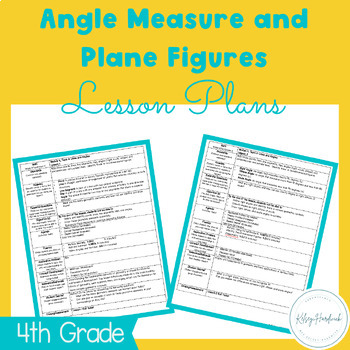4th Grade; Module 4: Angle Measures and Plane Figures LP
- Zip
What educators are saying
Also included in
- *This is a growing bundle and the price will increase soon. This resource contains lesson plans for Modules 1-7 4th Grade Math. 1.) Module 1- Place Value, Rounding, and Algorithms for Addition and Subtraction2.) Module 2- Unit Conversions and Problem Solving with Metric Measurements 3.) Module 3- MuPrice $40.27Original Price $44.75Save $4.48
- This resource contains lesson plans for Modules 1-7 4th Grade Math. 1.) Module 1- Place Value, Rounding, and Algorithms for Addition and Subtraction2.) Module 2- Unit Conversions and Problem Solving with Metric Measurements 3.) Module 3- Multi-Digit Multiplication and Division4.) Module 4- Angle MeaPrice $91.13Original Price $101.25Save $10.12
Description
This resource contains lesson plans for all 16 lessons in Module 4: Angle Measure and Plane Figures of 4th Grade Math.
This resource aligns to and can be used for any of the following:
- 4th Grade Math CCSS
- Engage {NY}/{Eureka}
- Lines and Angles
- Angle Measurement
- Problem Solving with the Addition of Angle Measures
- Two-Dimensional Figures and Symmetry
There are 2 versions:
1.) Fully completed lesson plans (PDF Version)
2.) Fully completed and editable PPT Version
*These lesson plans still align with the same content curriculum but in order to be compliant with copyright and trademark, the application problems have been removed but there is still a section for you to add your own. Vocabulary and essential questions have been added above the objective. I have customized my own version of the lesson plans to meet your needs and for you to use, if you choose. You are able to edit and add any changes necessary to the (editable PPT) version.
*They now include the full standards.
These plans are not meant to replace the Teacher Edition. They are meant to serve as a guide or an easy reference. They are a lesson plan format of what is in the Teacher Edition.
I have created a single page for each lesson so you can print the lessons you need for each week.
This curriculum can be extremely overwhelming. I hope these plans help you feel more comfortable, organized and prepared to teach. These are meant to be a time saver for those that teach this curriculum.
Terms of Use:
This product includes a fully complete PDF version and a fully complete-editable PPT version. No part of the product may be used or distributed except by the teacher that purchased it. Removal of any copyright information is a violation of the terms of use. This product should only be used by the teacher who purchased it. This product is not to be shared with others. Please buy the correct number of licenses if this is to be used by more than one teacher.
Follow Me
Be sure to follow me to receive future updates.
Let's Connect:
Did you know?
You can receive TPT store credits to use on future purchases by leaving feedback on the products you buy! Just click on "My Purchases" under "Buy"!







